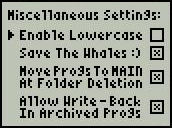Ever since the release of MirageOS 1.0 around 2000, the TI calculator community has strived to find out the purpose of the mysterious "Save the Whales" option in the MirageOS settings.

Finally, the mystery has been solved. The "Save the Whales" option in the settings has no effect whatsoever other than setting/resetting a bit in the MirageOS AppVar so it can remember the setting.
However, there is a "Save the Whales" secret. If you create three folders (in order) called "SAVE", "THE", and "WHALES" (as shown below), a token hook will be installed.

This token hook renames some of the built-in commands, as described and shown below:

| Original Name | New Name |
|---|---|
| GarbageCollect | Andrew |
| fnInt( | JaSoNiSr33t( |
| >Dec | >JKDE |
| Circle( | Square( |
Unfortunately, this "feature" was removed after MirageOS v1.0, so you will have to download it in order to see for yourself, which you can do here.
The complete disassembly of MirageOS 1.0 is downloadable in a couple of different formats as well.
For those unbelievers out there, the code which makes the decision whether or not to install the token hook is shown below, located at address 68DBh:
seg000:68DB call getMirageAppVar
seg000:68DE ld a, b
seg000:68DF ex de, hl
seg000:68E0 ld de, copyBuffer
seg000:68E3 ld bc, 150
seg000:68E6 rst 28h
seg000:68E7 dw 5017h ; _FlashToRam
seg000:68E9 ld hl, copyBuffer
seg000:68EC ld de, 9
seg000:68EF add hl, de
seg000:68F0 ld e, (hl)
seg000:68F1 add hl, de
seg000:68F2 ld de, 17h
seg000:68F5 add hl, de
seg000:68F6 push hl
seg000:68F7 push hl
seg000:68F8 ld bc, 20
seg000:68FB call getchecksum
seg000:68FE ld de, 4F9h
seg000:6901 call cphlde
seg000:6904 pop hl
seg000:6905 jr nz, loc_691E
seg000:6907 ld c, 5
seg000:6909 add hl, bc
seg000:690A ld a, (hl)
seg000:690B cp 53h ; 'S'
seg000:690D jr nz, loc_691E
seg000:690F add hl, bc
seg000:6910 ld a, (hl)
seg000:6911 cp 54h ; 'T'
seg000:6913 jr nz, loc_691E
seg000:6915 add hl, bc
seg000:6916 ld a, (hl)
seg000:6917 cp 48h ; 'H'
seg000:6919 jr nz, loc_691E
seg000:691B call enableTokenHook
seg000:691E loc_691E:
seg000:691E pop hl
seg000:691F ret
You'll notice that this routine calls "getchecksum", which is a routine available in mirage.inc. It simply adds up BC bytes pointed to by HL and returns that number in HL (a checksum, naturally, which in this case is 04F9h). The routine itself, which I've called "SaveTheWhales" here, is called in curfoldname and possibly in other places as well.
An interesting side effect of this routine is that some other folder names besides "SAVE", "THE", and "WHALES" can be used; for example, "SCAR", "THE", "SHOALS", or "SALT", "THE", "PHAGEL."
Anyway, once the check for the three folders succeeds, the hook is installed, which is located at address 7A5Dh:
seg000:7A5D add a, e
seg000:7A5E push hl
seg000:7A5F ld hl, 2
seg000:7A62 rst 28h
seg000:7A63 dw 400Ch ; _CpHLDE
seg000:7A65 jr z, loc_7A90
seg000:7A67 ld hl, 546h
seg000:7A6A rst 28h
seg000:7A6B dw 400Ch ; _cphlde
seg000:7A6D jr z, loc_7A8B
seg000:7A6F ld hl, 48h ; 'H'
seg000:7A72 rst 28h
seg000:7A73 dw 400Ch ; _cphlde
seg000:7A75 jr z, loc_7A86
seg000:7A77 ld hl, 14Ah
seg000:7A7A rst 28h
seg000:7A7B dw 400Ch ; _cphlde
seg000:7A7D jr z, loc_7A81
seg000:7A7F pop hl
seg000:7A80 ret nz
seg000:7A81 loc_7A81:
seg000:7A81 ld hl, aSquare ; "\aSquare("
seg000:7A84 jr loc_7A93
seg000:7A86 loc_7A86:
seg000:7A86 ld hl, aJasonisr33t ; "\fJaSoNiSr33t("
seg000:7A89 jr loc_7A93
seg000:7A8B loc_7A8B:
seg000:7A8B ld hl, aAndrew ; "\x06Andrew"
seg000:7A8E jr loc_7A93
seg000:7A90 loc_7A90:
seg000:7A90 ld hl, aJkde ; "\x05\x05JKDE"
seg000:7A93
seg000:7A93 loc_7A93:
seg000:7A93 ld de, localTokStr+1
seg000:7A96 ld bc, 16
seg000:7A99 ldir
seg000:7A9B ld hl, localTokStr
seg000:7A9E pop bc
seg000:7A9F ret
seg000:7AA0 aJkde: .ascii '\x05\x05JKDE'
seg000:7AA6 aAndrew: .ascii '\x06Andrew'
seg000:7AAD aJasonisr33t: .ascii '\fJaSoNiSr33t('
seg000:7ABA aSquare: .ascii '\aSquare('
There it is, staring at us right in the face for over 6 years.